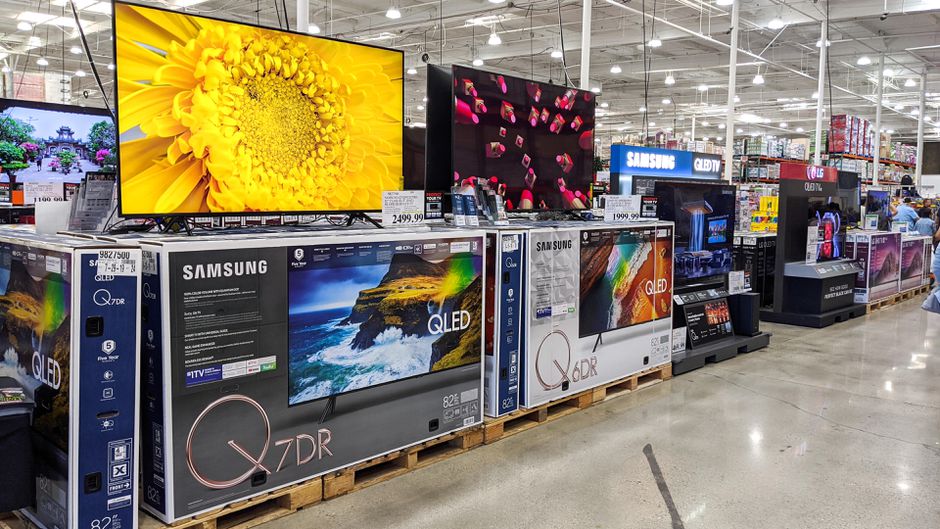TV Buying Guide : How to Choose a TV

Tue, Mar 09, 2021 07:43 AM
When it comes to a large purchase like television, you want to make sure you're making the right choice. With that in mind, here's a quick rundown on how to pick the best TV for you.
-
Look for brands like LG Electronics, Sony, or Samsung that are known for their quality.
-
Choose a television that is the right size for your room.
-
With 4K Ultra HD and HDR, you'll get the best picture possible.
-
To stop flickering images, look for a TV with a native refresh rate of 120 Hz or 240 Hz.
-
Check to see if your television has enough ports to attach all of your television accessories.
-
With a soundbar or surround sound device, you can take the audio experience to the next level.
-
The best time to buy a new TV is between November and February.
What to Look for When Buying a Television
First and foremost, make sure that your TV's resolution, weight, measurements, and inputs meet your requirements. To learn more about technical specifications and features, click on the links below.
Screen resolutions
-
What is the screen resolution?
The number of pixels per inch on your television determines how clear and crisp the picture is.
-
What should my TV's screen resolution be?
The best TV resolution right now is 4K Ultra HD (UHD), so if you want an awesome shot, we recommend 4K UHD TVs.
However, on TVs smaller than 32 inches, 4K UHD makes no difference, but Full HD (1080p) or even Standard HD (720p) will suffice.
-
High Dynamic Range (HDR)
HDR TVs have a wider range of colors, which improves the vibrancy and contrast of the picture. The picture quality varies from TV to TV, and HDR specifications aren't very useful in determining which TV is best.
There are a number of competing HDR specifications that all aim to enhance your viewing experience in various ways, but most content can work with either form of HDR.

Also, Read: How to control your TV and use your smartphone as a remote
Display type
Display style, also known as TV lighting, refers to how your TV screen is lit. The most popular type nowadays is LED-LCD, also known as LED, which is a modern variant of LCD.
A liquid crystal display (LCD) is a panel that either blocks or allows light to pass through particular areas on your screen in LED TVs. Light-emitting diodes illuminate the screen from the top, back, and sides.
Organic light-emitting diodes, or OLEDs, are a form of display that integrates light directly into the display, removing the need for liquid crystal displays.
This provides a rich color contrast that LED can't match. Although the technology is costly, if you can afford it, you will be rewarded with a stunning image with a large viewing angle.
Screen refresh rates
-
What are the different types of screen refresh rates?
The refresh rate refers to how often your screen's frame—or picture—changes. This is what gives video the appearance of movement. Traditionally, this occurs sixty times per second, which is denoted by the symbol "60 Hz."
-
How important are screen refresh rates?
If you're watching sports or action movies, a refresh rate of 120 Hz or 240 Hz will make the image look less choppy.
However, check to see if the refresh rate is listed with a marketing word like "smooth" rather than the true native refresh rate. Using overly market-y words or a ridiculously large number like 600 Hz normally means motion interpolation is used to achieve the high speed.
Motion interpolation makes an image appear crisp—perhaps too crisp—but it's simply flickering the same frame several times to fool your brain into thinking it's not. Since all that crispness can make your shows look like cheap daytime television, the result is known as the "Soap Opera Effect."
If you buy a TV with a high refresh rate that relies on motion interpolation, you should be able to disable this feature to avoid the Soap Opera Effect.
TV ports and connections
It's important to double-check that a TV has the right ports for your DVRs, streaming devices, game consoles, and soundbars. Since only HDMI can offer 4K UHD and the best sound, most modern TV-related devices use HDMI ports.
If you have some old analog accessories, such as an old game console, make sure the TV you're considering has the ports for the cables or connectors you'll need.
TV sound systems
A big home theater should be combined with at least a 5.1 surround sound system for the best experience. A soundbar, on the other hand, will suffice in smaller spaces.
Whatever sound system you choose, it will be superior to the built-in speakers on your television. Modern televisions are too small to have strong built-in speakers.
TV antennas
While some modern TVs have a built-in digital antenna, you'll almost always need to boost your reception because they don't get a very good signal.
If you're going to buy a TV antenna, make sure it's powerful enough to pick up signals broadcast over the air from local TV stations.
Pairing a TV antenna with your new TV is a perfect way for cord-cutters to get local channels in HD. However, if you already have a cable subscription, it might be redundant, so don't be concerned.
Smart TVs vs. non-smart TVs
Smart TVs have an internet connection, which is normally provided by an Ethernet port as well as Wi-Fi access. With this link, you can watch TV shows and movies on Netflix, Hulu, Amazon Prime, and YouTube, among other apps.
Is a smart TV worth it?
It's great to be able to stream directly from your TV, but you don't need a smart TV to do so. By connecting a streaming system like Roku or Fire TV to any non-smart TV with an HDMI input, you can transform it into a smart TV.
These streaming devices perform the same functions as a smart TV and are relatively inexpensive. Don't let a smart TV be the deciding factor in your purchase.
Best TV brands
With hundreds of different TV brands and models to choose from, it's a good idea to know which brands are usually reliable and cost-effective before you purchase.
Thanks to its incredible picture quality and large viewing angles, LG Electronics is widely regarded as a top-tier TV maker. Sony and Samsung are two other well-known brands with solid reputations.
If you're looking for a more budget-friendly option, TCL and VIZIO have some fantastic TVs available.
-
LG-best picture quality
-
Samsung-best overall
-
Sony-best sound system
-
TCL-best budget TVs
-
Toshiba-Amazon Fire TV integration
-
VIZIO-good value
Worst TV Brand
Both Insignia and Sanyo have a bad reputation for producing low-quality goods with ongoing problems, so avoid them. Sharp's TVs are also lagging behind the market, as the company seems to be more focused on the rest of its vast product range.
-
TV size vs. room size
The appropriate TV size is determined by the size of your bed. Consider how uncomfortable it is to sit in the front row of a movie theater: your head craned, the edges of the screen out of sight, and the action rushing at you way too fast.
- How big the TV should be?
For a bedroom, choose a TV between 40′′ and 60′′, and for a medium-sized living room, choose one between 49′′ and 60′′. When it comes to TVs, bigger is better, but an enormous TV is a waste of space in a tiny room.
To be honest, some of the rooms are... uncomfortable. Remember that because of a basic principle called viewing angle, you won't be able to see your TV from every nook and cranny, regardless of the size or shape of your space.
-
What exactly is a viewing angle?
The viewing angle is the farthest side of the TV from the middle where you can sit and still get a good shot. It's necessary to check alternative angles because sitting at any angle other than straight onto the TV will result in a loss of color and contrast.
-
How important is the viewing angle?
Any TV will suffice if you just want to watch it from the front. However, if you have several seating arrangements in front of the TV, you'll want to think about the viewing angle so that everybody can see what's going on.
So, What is the best TV to buy?
For the most part, we believe the 55-inch Samsung Q90T QLED TV is the best smart TV available. However, the best TV to buy is determined by your budget, room size, and viewing preferences.
Do you need assistance with the next step in your TV or projector purchase? One of our expert reviews of the best TVs and projectors on the market can be found here.
Featured Plan

Bundles starting from $39.99/mo.
With Xfinity, you can get an amazing internet speed up to 1000 Mbp, over 260+ of digital TV channels, unlimited talk time nationwide, business plan, and home security services. Xfinity Comcast is the largest cable provider in the US.
View More Deals! (833) 396-3209